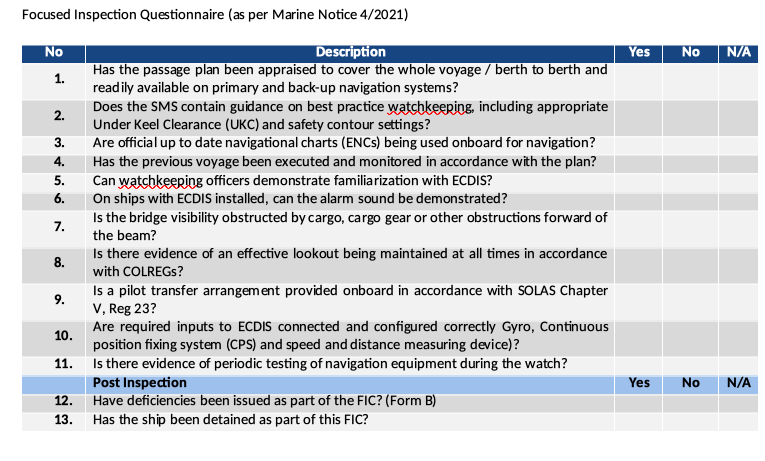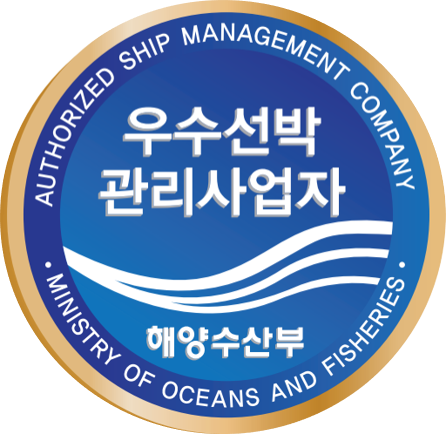추가) AMSA’s FIC on Safety of Navigation: A best practice guide
페이지 정보
작성자 최고관리자 댓글 0건 조회 1,040회 작성일 21-07-30 18:30본문
AMSA’s Focused Inspection Campaign on Safety of Navigation:
A best practice guide
The campaign will be conducted from 1 August 2021 to 30 September 2021
by The Editorial Team
AMSA announced that a Focused Inspection Campaign on Safety of Navigation will be conducted from 1 August 2021 to 30 September 2021. AMSA surveyors will undertake the FIC in conjunction with Port or flag State Control inspections. SQEMARINE provides guidance for the questionnaire of the campaign and a best practice guide as well as analysis on AMSA findings on Deficiency Category.
The purpose of the focused inspection campaign is to determine the level of compliance with the safety of navigation requirements of International Conventions and the familiarity of the master and officers with their processes for ensuring safety of navigation. Additionally, AMSA PSCOs will check familiarity with SOLAS Chapter V, Australian Marine Order 27 and their safety management systems implemented onboard.
As part of AMSA’S Safety of Navigation Focused Inspection Campaign, AMSA PSCOs will be using a checklist during ship inspections.
Actions required
Ship managers should be prepared to address related FICs items. Safety of Navigation plays a key role to ship operations, considering that several serious incidents and accidents have occurred due to inadequate implementation of rules and practices on safe navigation.
Focused Inspection Questionnaire (as per Marine Notice 4/2021)
 Best Practice
Guidance on FIC Questionnaire
Best Practice
Guidance on FIC Questionnaire
- Has the passage plan been appraised to cover the whole voyage / berth to berth and readily available on primary and back-up navigation systems?
The passage plan should be thoroughly checked by navigation officer and then demonstrated to Master. After final Master’s approval, the plan should be discussed on a briefing with all OOWs. The plan should cover all voyage from starting berth to ending port’s berth (or anchorage). Some ship operators may request the plans to be sent to Head Office for verification by a Marine Superintendent or Port Captain(only electronic passage plans exported from ECDIS).
The final plan signed by Master should be available for use on primary and secondary navigation systems as they have declared in Ship’s “Record of Equipment”.
Available options are:
a Nautical Paper Charts Only (primary method of planning paper charts, no back up plan is required)
b. Two ECDIS (No Nautical Paper Charts). The ship is paperless for navigation. The plan should be uploaded on both ECDIS systems.
c. ECDIS and Nautical Paper Charts. The ship has installed 1 ECDIS system and use full set of paper charts. The plan should be uploaded on ECDIS and additionally should be available on paper charts also. Both options should include exactly the same planning and parameters.
2. Does the SMS contain guidance on best practice watchkeeping, including appropriate Under Keel Clearance (UKC) and safety contour settings?
SMS should include a section with instruction on navigation watchkeeping. Master’s Standing orders should also provide additional guidance on Bridge Watch practices. The passage plan should include a dedicated section for UKC calculation.
For ships using only ECDIS for Navigation, special focus should be given on the CAZOC of ENC maps when calculating UKC.
3. Are official up to date navigational charts (ENCs) being used onboard for navigation?
ECDIS systems used on board should be supported by official ENC charts. Ship Managers are responsible to provide adequate resources for installing and supporting the ENCs. Charts from unknown sources or from not verified/approved suppliers should be avoided.
Ship Managers should arrange the update procedure for ENCs on board. This may be done with online facility, during which ship navigation officer verifies that the system is updated automatically on line with the chart provider. Alternatively corrections and updates may received with data storage devices (DVDs or USB Sticks) and should be uploaded by competent ship’s personnel.
Navigation officer may be required to conduct manual corrections, received through other means (eg VHF broadcasts, local port announcements etc). A dedicated log for such corrections should be available.
4. Has the previous voyage been executed and monitored in accordance with the plan?
For paper charts the voyage fix positions should be available for inspection. On ECDIS system the history facility may be used to check some previous parts of the voyage.
The Alarm history Log may also provide information for adequate plan’s execution. XTD alarms or danger areas crossing alarms may be indicative.
5. Can watchkeeping officers demonstrate familiarization with ECDIS?
All OOWs should be adequate certified for ECDIS system as per STCW. Additionally, system specific training and familiarization should be documented and demonstrated.
It is highly recommended an effective ECDIS familiarization procedure to be included in SMS of Supportive ECDIS management Plan in order to provide OOWs adequate knowledge and familiarization with ship’s specific systems.
All officers in charge of navigational watch should be able to demonstrate simple functions of ECDIS, such as Safety Parameters setting, alarm handling and knowledge, charts selections etc.
6. On ships with ECDIS installed, can the alarm sound be demonstrated?
All OOWs should be aware of the proper use of ECDIS alarms. In particular, activation and acknowledgement of alarms should be demonstrated as part of familiarization procedure.
7. Is the bridge visibility obstructed by cargo, cargo gear or other obstructions forward of the beam?
This a ship specific item. In case of cranes or other cargo related items obstructing bridge visibility, OOW should be _alert_ed to change positions on bridge periodically in order to ensure adequate lookout as per COLREG Rule 5 “Every vessel shall at all times maintain a proper lookout by sight and hearing as well as by all available means appropriate to the prevailing circumstances and conditions so as to make a full appraisal of the situation and of the risk of collision.”
8. Is there evidence of an effective lookout being maintained at all times in accordance with COLREGs?
As per above item 7, continuous lookout should be ensured. Specially during reduced visibility and during night hours a dedicated lookout should be stationed additionally to other watch personnel. SMS should include standardized bridge manning conditions related to visibility/traffic and weather in order to ensure sufficient and competent manning on the bridge.
Bridge Log should include details when bridge status is changing from one condition to other in order to be used as evidence for appropriate watch keeping.
9. Is a pilot transfer arrangement provided onboard in accordance with SOLAS Chapter V, Reg 23?
Pilot transfer arrangements should be adequate maintained and placed as required. Pilot ladders is the first item for check when a pilot boards a ship along with the supportive equipment (ropes, lifebuoys, lights, pyrotechnics etc).
When pilots identify hazardous conditions on such arrangements, they usually communicate abnormalities to relevant PSC section for further inspection. Safety Officer on board should arrange the periodic inspection and rectification of every item related to pilot’s embarkation in order to avoid unnecessary deficiencies and above all hazardous situation for Pilot’s safety.
10. Are required inputs to ECDIS connected and configured correctly Gyro, Continuous position fixing system (CPS) and speed and distance measuring device)?
ECDIS systems should be checked periodically for adequate configuration and connection with supportive systems (Position systems and Gyro). In case of defects, Ship Manager should arrange rectification immediately.
11. Is there evidence of periodic testing of navigation equipment during the watch?
An effective handover procedure should be in place for Officer in charge of Navigational watch. Several critical systems should be checked by the Officer who takes over the watch prior assuming duties.
The functionality of Navigational Lights, Radars, ECDIS (with connected equipment as gyro,, Positioning systems), AIS, speed log and communication means should be thoroughly checked during this procedure. Master in standing orders should make reference to the importance of such procedure.
AMSA Deficiencies on Safety of Navigation (Last 3 Years)
 Source:
RISK4SEA
Source:
RISK4SEA




